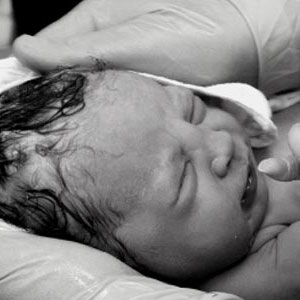
Newborn babies don't need to be held down around their mother's vagina while the last of the placental blood makes its way through the umbilical cord, according to a new study.
Waiting a couple of minutes after a baby is born to clamp and cut the umbilical cord is generally considered a good idea, and some authorities have recommended holding the newborn level with the vagina so gravity can help draw extra blood from the placenta.
Very old studies
But babies held that way didn't seem to get any more placental blood than babies held in their mother's arms instead, the new study found.
Read: Soothing your newborn
"The fantasy that gravity plays a role was based on very old studies," Dr Nestor E. Vain told Reuters Health.
Vain worked on the study at the Foundation for Maternal and Child Health in Buenos Aires, Argentina.
The uterus continues to contract after the baby is born, and those contractions are what push blood through the umbilical cord, not gravity, he said.
Between 2011 and 2012, Vain and his team recruited about 400 women in labour at three hospitals in Argentina. With hospital cooperation, half of their babies were held at the level of the vagina after birth and the other half were placed on their mother's abdomen or chest for two minutes before the umbilical cord was clamped.
Same amount of blood
The babies were weighed immediately after birth and again after the cords were clamped.
Based on their weights, babies in both groups seemed to gain about the same amount of blood regardless of where they were held, according to results published in The Lancet. In the abdomen/chest group, babies gained an average of 53 grams, or about a tenth of a pound, compared to 56 grams in the vagina-level group.
"At any time during pregnancy in the last trimester, one third of the foetal blood in the baby is circulating in the placenta, which is where the baby's blood goes to get oxygen and sugar from the maternal blood and eliminate carbon dioxide like the kidney of an adult," Vain said.
That blood needs to get to the baby before the cord is clamped or cut, he said. Waiting one to four minutes to clamp decreases the baby's risk of iron-deficiency anemia and neurodevelopmental problems, which are a concern in Western as well as developing countries, he said.
Read: Delayed umbilical cord clamping may help preemies
"In preterm infants, we know that more blood improves baby's blood pressure, reduces the need for blood transfusions, reduces the risk for having intracranial bleeding, and helps in the smooth transition between foetal and neonatal cardiovascular adaptation," said Dr Tonse N.K. Raju.
Delaying cord clamping
Raju, from the Eunice Kennedy Shriver National Institute of Child Health and Human Development at the National Institutes of Health in Bethesda, Maryland, wrote an editorial accompanying the study.
Most doctors know that delaying clamping the cord is important, but recommendations that a doctor or nurse hold the baby down low for gravity's sake mean it doesn't always happen, Vain said.
"Two minutes, that's a long time to stay holding a baby who is kicking, screaming and slippery," he said.
Hopefully delayed cord clamping will happen more often now that researchers know giving the baby to its mother, which has other benefits, is okay, he said.
Mother and infant bonding
"Many studies have shown that infant-and-mother attachment and bonding improves by direct physical contact soon after birth between mom and her infant," Raju told Reuters Health in an email.
Read: Newborns struggle to survive
"More importantly, keeping the infant on mom's chest helps the infant to immediately begin to latch on to mom's nipple, begin sucking, and establish early on a successful pattern for breastfeeding," he said.
Latching on helps release more of the hormone oxytocin, which can help contract the now-empty uterus and deliver the placenta, he added.
"Many believe that this is the evolutionary basis for a relatively long umbilical cord," Raju said. "That is, this enables the mom to grab her newly born baby, put the baby on her chest to help the baby to begin to suckle, which has a dual advantage of helping the delivery of the placenta."
Read more:
Umbilical cord milking has benefits
Wait before cutting cord




 Publications
Publications
 Partners
Partners














